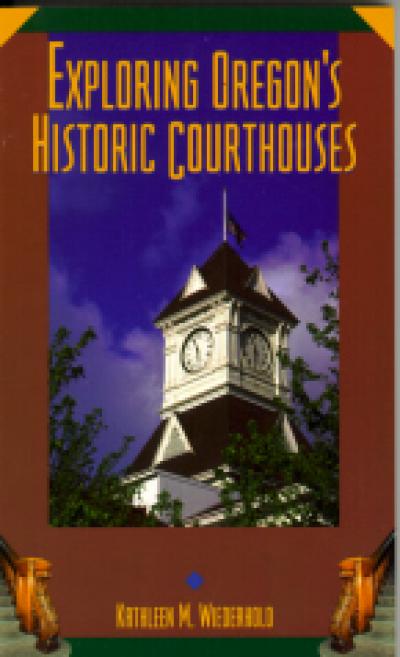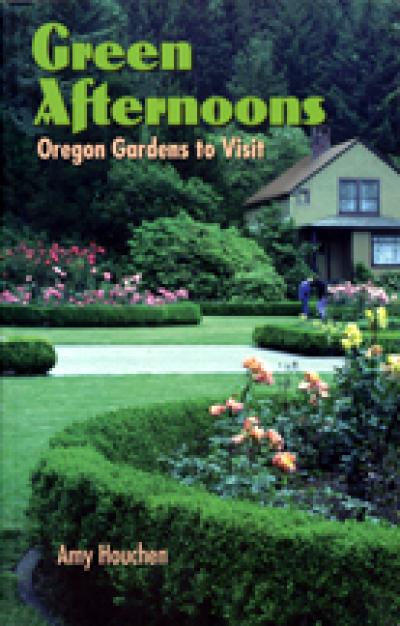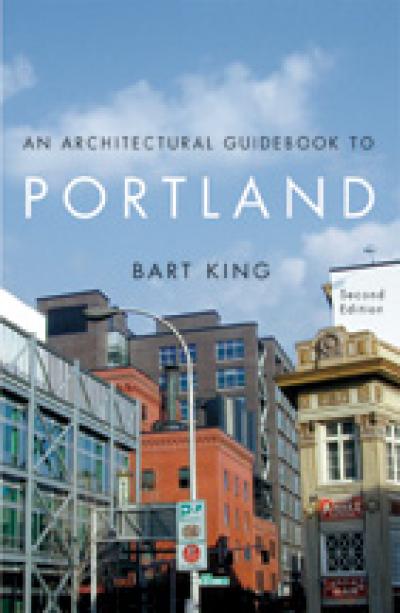
Exploring Oregon's Historic House Museums
Kathleen M. Wiederhold
Oregon's historic house museums are time capsules that preserve our past domestic life. As Kathleen Wiederhold shows in this informative and entertaining guide, historic houses provide a place to experience the architecture and artifacts of the most intimate part of our lives, the home.
Each of the historic house museums featured is unique in its place and time. The book covers houses built from 1841 to 1936, from a hewn log cabin in the high desert to a grand mansion in the state's most populated city. The houses, many of which are on the National Register of Historic Places, span the economic spectrum from poor to wealthy, and include those belonging to noteworthy Oregonians, from John McLoughlin to Wayne Morse. All are open to the public.
The author introduces readers to more than fifty historic house museums in towns and cities from Astoria to Baker City. Each profile includes:
- a fascinating history of the people who built and lived in the house.
- detailed descriptions of exterior and interior features, including architectural styles, floorplans, and furnishings,
- a step-by-step tour of the house with tips on what to see,
- and visitor information such as directions, operating hours, and nearby attractions.
Historic house museums showcase both ordinary and unusual objects that Oregonians used in everyday life. They provide glimpses of people's lives in the places where they lived. They also reflect on the course of the state's settlement and development. this engaging guide explains these dwellings and tells their stories. Photographs of both the exteriors and interiors bring the houses alive. For history buffs, old house enthusiasts, antique aficionados, and cultural tourists, this book is an excellent introduction to Oregon's heritage houses.
About the author
Kathleen M. Wiederhold is a scholar of and an advocate for Oregon's courthouses. She has spent 18 years researching historic buildings and town histories. She has an extensive collection of courthouse memorabilia. She currently lives in Spokane, Washington.
Read more about this author
Acknowlegements
Introduction
Map of Oregon
Portland Area
Bybee-Howell House (Portland)
Pittock Mansion (Portland)
Ermatinger House (Oregon City)
McLoughlin House (Oregon City)
Rose Farm (Oregon City)
Stevens-Crawford House (Oregon City)
Tigard House (Tigard)
Harlow House (Troutdale)
Northern Willamette Valley
Map of Northern Willamette Valley
Old Aurora Colony Museum:
Kraus House & Steinbach Cabin (Aurora)
Newell House (St. Paul)
Foster Farm (Eagle Creek)
Dibble House (Molalla)
Hoover-Minthorn House (Newberg)
Brunk House (Rickreall)
Bush House (Salem)
Deepwood Estate (Salem)
Mission Mill Museum:
Lee House, Parsonage & Boon House (Salem)
Settlemier House (Woodburn)
Southern Willamette Valley
Monteith House (Albany)
Moyer House (Brownsville)
Morse House (Eugene)
Shelton-McMurphey-Johnson House (Eugene)
Lower Columbia River
Flippin House (Clatskanie)
Caples House (Columbia City)
Coast
Flavel House (Astoria)
Lindgren Cabin (Astoria)
Yaquina Bay Lighthouse (Newport)
Seaside Museum: Butterfield Cottage (Seaside)
Columbia Gorge
Fort Dalles Museum:
Surgeons Quarters & Anderson Farmhouse (The Dalles)
Rorick House (The Dalles)
Eastern Oregon
Adler House (Baker City)
Kam Wah Chung Museum (John Day)
Frazier Farmstead Museum (Milton-Freewater)
Southern Oregon
Hughes House (Cape Blanco)
Drain House (Drain)
Schmidt House (Grants Pass)
Beekman House (Jacksonville)
Kerbyville Museum: Naucke House (Kerby)
Floed-Lane House (Roseburg)
Southeastern Oregon
Fort Rock Valley Homestead Village Museum:
Menkenmaier Cabin, Boedigheimer House, Webster Cabin, Belletable House (Fort Rock)
Schminck Memorial Museum (Lakeview)
Glossary
Sources Consulted
Index
Oregon's historic house museums are time capsules that preserve our past domestic life and provide a place to experience the architecture and artifacts of the most intimate part of our lives, the home. They help us to understand the evolution of common items that we have around us today, such as sofas and sinks, and showcase both ordinary and unusual objects that Oregonians used in everyday life.
This book also explores the lives lived in these houses. Buildings and objects become meaningful if we understand the human connection. By visiting the home where wealthy Sally Bush fed tramps, or seeing the cedar plank cabin that sixty-seven-year-old Erik Lindgren built with his own hands, we broaden our understanding of how Oregonians have lived.
Houses Included in this Book
Each of the houses profiled in the book has regular operating hours. However, some museums, such as the Adler house and Bybee-Howell house, are open only during the summer. Others, such as Rose Farm and the Settlemier house, are open only one day a month, usually on a Sunday. All the houses have scheduled hours. Since volunteers run many of these museums and the operating hours can change, call ahead to ensure that the house will be open. While visits to the house museums may take a little planning, they are definitely worth the effort.
Historical societies sometimes purchase historic houses and use them as museums to display local artifacts. Even though the structure is a house, the primary emphasis is to display historical items rather than to recreate a home atmosphere. I toured many of these museums and made judgements as to whether they were actually house museums. The decision to omit a museum sometimes was not easy, as many have a small budget and any additional publicity would be helpful.
Variety of Oregon's House Museums
Each house museum in the state is unique. This book features houses built from 1841 to 1936, and owned by those spanning the economic spectrum from poor to wealthy, including some noteworthy in Oregon's history, from John McLoughlin to Wayne Morse.
Oregon's house museums range from small cabins like the Webster dwelling in Fort Rock to Opulent homes like the Pittock mansion in Portland. some museums were farms, like the Brunk house near Dallas, while others are located in town, such as the Moyer house in Brownsville. The book includes three "castles," so designated by local residents because they are relatively grand.
Interiors of Oregon's House Museums
Tours can be guided or self-guided, and some museums offer both types. A few tours are unique, such as the living history tour at the Beekman house, where the "family members" are in character.
Some of the state's house museums, such as the Kam Wah Chung Museum and the Bush house, are preserved with the household furnishings and items that were owned by the original occupants. Many display household items donated by members of the local community; these collections, while sometimes portraying aspects of a house interior that are historically inaccurate, do present opportunities for whimsy.
Oregon's house museums afford glimpses of how Oregonians lived and the things they had around them in their homes. The complete picture is often illusive, despite our best efforts. For those who want a better understanding of our domestic past, I recommend first perusing the books in the General Sources section.
Background on Oregon's House Museums
Prior to the 1970s, some significant dwellings such as the McLoughlin house and Flavel house were used as museums displaying local history. Their preservation, however, sometimes generated protest. Citizens filed court injunctions against moving the McLoughlin house now a National Historic Site, to its current location on the bluff in Oregon City.
Ruth Powers stands out as a dedicated perservationist of Oregon's pioneer houses. Called by one of her admirers after her death in 1995 the "empress of historic preservation" in Oregon, she spent her own money to save many of today's house museums, such as the Rose Farm in Oregon City and Foster Farm in Eagle Creek.
Today, historical societies are some of the most common owners of Oregon's house museums. Ruth Powers transferred many of her houses to historical societies; others were simply bequeathed to these organizations, sometimes along with the furnishing, because the owner had a affinity for history. Other museums have been saved because they were the home of someone or some event significant in Oregon's history. A few house museums, such as Deepwood in Salem or Pittock in Portland, were purchased by the city because they are opulent structures. Frequently in these cases, while the municipality maintains the exterior, an organization such as the Friends of Deepwood is responsible for running the house and maintaining the furnishings.
How the Book is Organized
The house museums are grouped by geographical area. Each chapter profiles one house, except when a museum has multiple houses, such as Fort Dalles Museum or the Fort Rock Valley Homestead Village Museum.
Each chapter begins with an address, directions, and neighborhood map. For many of the houses, the directions are given from the freeway. If a visitor could be coming from either direction, the directions state, for example "turn east" instead of "turn right." this section also notes whether the house is listed on the national Register of Historic Places, meaning that it has been deemed to be significant architecturally and/or historically. Additional Attractions suggest other places such as nearby house museums or parks to visit while in the area.
The History section includes important features about the museum's site or the area in close proximity.
The Exterior section examines significant aspects of the appearance of the house, including characteristics that define its architectural style and features that distinguish the building.
The Interior section, the largest section of each chapter, provides a step-by-step tour of the inside of the house and is more detailed than the usual overview given by the docent. It provides insight into aspects of the floor plan, interior design, technology of the item, and the artifacts on display. For perspective, I have included quotes from people of the times. When available, I also have included rich stories connected with the house.



